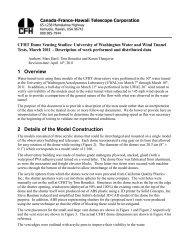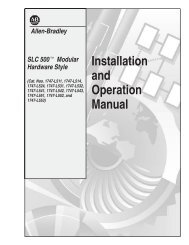Documentation [PDF] - Canada France Hawaii Telescope ...
Documentation [PDF] - Canada France Hawaii Telescope ...
Documentation [PDF] - Canada France Hawaii Telescope ...
Create successful ePaper yourself
Turn your PDF publications into a flip-book with our unique Google optimized e-Paper software.
Wide field σ u ∗ σ g σ r σ i σ z<br />
[mag.] [mag. ] [mag. ] [mag. ] [mag. ]<br />
W1 0.020 0.010 0.015 0.013 0.020<br />
W2 0.020 0.010 0.012 0.011 0.023<br />
W3 0.025 0.010 0.015 0.011 0.019<br />
W4 0.016 0.009 0.008 0.013 0.016<br />
Table 9: Internal field-to-field photometric errors in the T0007 CFHTLS Wide release derived from sources in<br />
adjacent tiles. These internal errors are computed from the T0007 “merged source catalogues” (M-SC, see Section<br />
6.3) which contains MAG_IQ20 for sources detected on the u ∗ , g, r, i/y, z and chi2 images. They are derived<br />
from the mean of the absolute magnitude differences of source pairs, averaged over overlapping regions of neighboring<br />
stacks. Only bright stars are used to derive a robust field-to-field offset for each contiguous tile pair. The<br />
limiting magnitudes are u < 19, g < 22, r < 20, i < 21, z < 19 These values should be regarded as an upper<br />
estimate of the errors as they are calculated using the stack edges which have lower signal-to-noise due to the<br />
dithering.<br />
of these field to field offsets is a estimator of the field to field scatter. The values for each field and filter<br />
are listed in Table 9. To compare these errors with estimators calculated from a comparison to a reference<br />
catalogue used in Section 4.4.3, a hypothesis has to be made on the distribution of this random variable.<br />
If we assume that photometric measurement are Gaussian-distributed around the “true” photometry with<br />
a dispersion of σ, then the dispersion of the field to field offsets is a Gaussian with a dispersion √ 2σ. The<br />
values of Table 9 must be divided by √ 2 to be compared with the field to field estimations of Table 12.<br />
The errors are larger in u ∗ and z bands for several reasons: the residuals from fringe subtractions in z,<br />
the poorer image quality in u ∗ , especially at the edges of the stacks, and the residuals from the internal<br />
calibration errors. Considering the factor of √ 2, these errors are completely consistent with an overall<br />
photometric field to field scatter of 1% in g,r and i and 1.5% in u ∗ and z.<br />
The second estimate of internal photometric errors which can be determined from the analysis of objects<br />
observed in multiple tiles is the measurement error. Since the images are photometrically flat, the dispersion<br />
of the magnitude offsets around the mean field-to-field shift of objects detected in multiple tiles<br />
is dominated by statistical measurements errors. This dispersion as a function of magnitude is plotted<br />
as the vertical error bars in Figure 35 for each of the four Wide patches and is listed in Table 10. In<br />
this analysis, both stars and galaxies are included; magnitudes are estimated using MAG_AUTO to yield a<br />
realistic estimate of measurement errors for both stars and galaxies. We also note the plots are broadly<br />
similar for each of the four patches, confirming the homogeneous nature of the Wide survey. The z−band<br />
errors are several times higher that other bands; for these longer wavelengths fringing residuals become<br />
an true issue.<br />
The dispersion distributions are fitted with third order polynomials. To compare these values to the<br />
direct estimation of measurement errors in the simulations, one has to assume a gaussian distribution<br />
(dispersion σ M ) of the measured magnitude around the true magnitude. The distribution of the magnitude<br />
differences is then a Gaussian distribution with a dispersion equal to :<br />
These errors are listed in Table 10.<br />
σ diff = √ 2 × δ M (13)<br />
Comparing these errors with those derived from the simulations shows that the errors from the overlaps<br />
49


![Documentation [PDF] - Canada France Hawaii Telescope ...](https://img.yumpu.com/26965302/61/500x640/documentation-pdf-canada-france-hawaii-telescope-.jpg)









